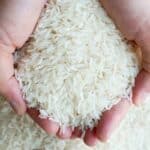The World Bank’s food security update of August 2022 flagged how global concerns over the likelihood of a rice export ban by India are rising. It noted that ‘exporters, concerned that export restrictions will be introduced (as has been done for wheat), are moving quickly to open letters of credit and have signed contracts to export 1 million tonnes of rice from June through September 2022.’ But are these concerns real? Is there any cause for worry in the case of Indian rice? Estimates show that even though there is no palpable threat to India’s food security, the window of Indian rice exports this year may be constrained.
In 2021-22, India produced about 130.29 million metric tonnes (MMTs) of rice. About 86 percent of this (about 112 MMTs) was produced during the Kharif season (sown during June/July and harvested during November/December). The remaining 14 percent was produced in the winter months during the Rabi season.
As per NITI Aayog’s demand and supply projections, India’s projected consumption in 2022-23 will be about 108 to 109 MMTs of rice. In addition to the central pool stocks of rice with the government, the private sector also maintains some stocks of rice that move between crop years. But, if we assume for the sake of understanding, zero opening and closing rice stocks, then it appears that last year, the country generated a surplus of about 22 MMTs (130.29 – 108.28). This was approximately the amount of rice that was exported from the country last year. However, this will not be the case every year, as stocks both with the Food Corporation of India (FCI) and the private sector play an important role in India’s rice balance sheet.
Problems for India’s rice crop this year
This year, there are news reports of lower paddy acreage and yield. But it is not just the area coverage that is lower than last year. There are reports of the drying of transplanted paddy crop in fields primarily due to lack of irrigation. Inter alia, there appear to be three reasons for this. First, deficit rains in key paddy growing states of Uttar Pradesh, Bihar and West Bengal, which produce about one-third of India’s paddy. Second, dwarfing of rice plants caused by a Southern Rice Black Streaked Dwarf Virus (SRBSDV) attack and third, more remunerative price incentives for sister crops like soybean, and cotton.
Kharif is the main cropping season in India and it pivots on monsoon rains. About 52 per cent of India’s gross cropped area has assured irrigation, as per data from the Ministry of Agriculture. This implies that about 48 per cent area depends directly on monsoon rains for irrigation. Even in irrigated areas, rains are needed to reduce dependence on electricity and diesel. So, if there is serious deficiency in rainfall, the crop production and its costs of cultivation are bound to be adversely impacted.
As of 29 August 2022, India’s monsoon showers are about 7 per cent above their long-period average value (LPA). Interestingly, the LPA value has itself been adjusted downwards this year in light of shrinking volumes of Indian monsoon rains over time. Despite a good monsoon figure at an all-India level, six states/Union Territories have received deficient rains. These states include Uttar Pradesh (with a rain deficit of 44 per cent), Bihar (with a deficit of 39 per cent), Jharkhand (deficit of 26 per cent), Manipur (deficit of 44 per cent), Tripura (deficit of 28 per cent) and Delhi (deficit of 31 per cent). Until recently, West Bengal was also in this category. However, a recent spurt in rains has pulled up its rain measure, though it still shows a deficit of about 18 per cent.
Source: the print
The following reports may be of interest to you:
The Ministry of Agriculture of Ukraine Predicts a 10% Decrease in the Harvest in 2024
Egyptian GASC Procures Wheat at Higher Prices in Recent Tender
Basmati Rice Sets New Milestone By $5 Billion Export
Wheat Inventory Falls to 16-Year Low, Nearing Buffer Limit
Market Pressure Leads to Decreasing Corn Prices










